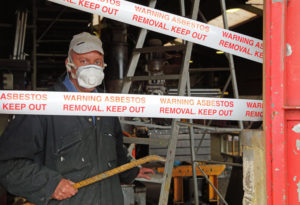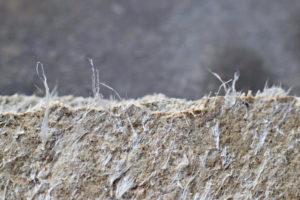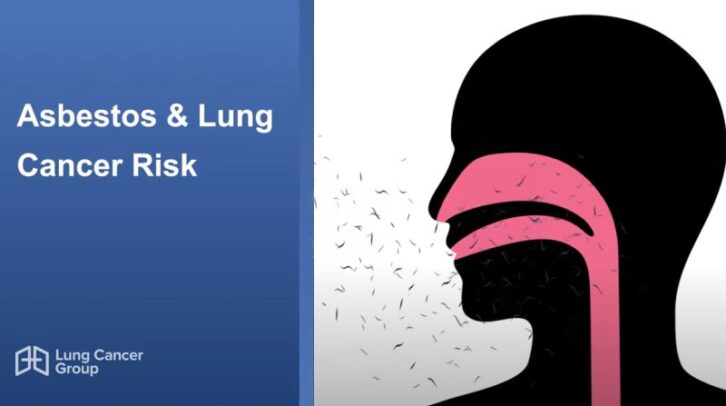Asbestos
Asbestos is a durable mineral made up of microscopic fibers that causes lung cancer, mesothelioma, and other diseases. Millions of people were exposed to asbestos in various products, and companies hid the health risks for decades. If you suffered asbestos exposure and are now sick, our team may be able to help you pursue financial compensation.
What Is Asbestos?
 Asbestos is a carcinogen (cancer-causing substance) used in consumer materials for decades. Exposure to asbestos products can cause lung cancer later in life.
Asbestos is a carcinogen (cancer-causing substance) used in consumer materials for decades. Exposure to asbestos products can cause lung cancer later in life.
Quick Facts About Asbestos and Cancer
- What does asbestos look like? Asbestos looks like bundles of white, grey, green, or yellow fibers.
- How was asbestos used? Asbestos was used in thousands of products from the 1930s to the early 1980s since it was heat-resistant and a good insulator. Manufacturers hid the risks for decades to make billions of dollars.
- How does asbestos cause cancer? Breathing in or swallowing asbestos fibers can lead to irritation and mutate healthy cells. This can cause lung cancer, mesothelioma, and other cancers 10-50 years later.
- How many people are at risk? Over 27 million people had been exposed to asbestos by the time the health risks became well-known in the early 1980s.
- How many people die from asbestos? An estimated 40,000 Americans die from asbestos-related diseases each year.
Lung Cancer Group can help you explore your treatment options and pursue compensation for medical costs if you have asbestos-related lung cancer. Get started with our Free Lung Cancer Guide.

- Understand risk factors
- Find top treatments
- Pursue compensation



Asbestos-Related Diseases
People exposed to asbestos could develop any number of illnesses decades later, such as mesothelioma, lung cancer, and asbestosis. Learn about the most notable asbestos-related diseases below.
Lung Cancer
Lung cancer is the most common type of cancer caused by asbestos exposure. Roughly 8,500 to 10,500 people die of asbestos lung cancer every year, according to data from the U.S. Centers for Disease Control and Prevention (CDC).
You could develop asbestos lung cancer even if you smoked. In fact, asbestos fibers worsen the damage that smoking does to the lungs.
“Smokers who are also exposed to asbestos have a risk of developing lung cancer that is greater than the individual risks from asbestos and smoking added together.”
— National Cancer Institute (NCI)
While lung cancer is very aggressive, it’s possible to live for 15 years or more with the right treatment. Jim was diagnosed with advanced asbestos lung cancer in 2005 but is still alive today after undergoing surgery, chemotherapy, and radiation.
Mesothelioma
Malignant mesothelioma is a cancer that forms in the linings of the lungs, heart, abdomen, or testicles. The only known cause of mesothelioma is asbestos exposure.
About 3,000 people develop mesothelioma each year. There’s currently no cure, but treatments can help those diagnosed live longer. Some mesothelioma patients have lived for 20 years or more thanks to the medical care from top doctors.
If you or a loved one was exposed to asbestos, you could develop lung cancer 10-50 years later. Healthy lung tissue can suffer long-term irritation due to asbestos fibers, eventually leading to cancer.
Duration: 1 min 10 sec
Other Asbestos-Related Cancers
Asbestos exposure can lead to a number of different cancers besides mesothelioma and lung cancer.
Other asbestos cancers include:
- Colon cancer
- Gastrointestinal cancer
- Ovarian cancer
- Rectal cancer
- Throat cancer
Financial compensation may be available if you or a loved one has an asbestos-related cancer. Call (877) 446-5767 now to learn more.
Asbestosis
Asbestosis is a chronic condition in which the lungs stiffen over time. Symptoms include difficulty breathing and chest pain. Like mesothelioma, the only known cause is asbestos.
Asbestosis is not cancer, but it’s still very dangerous and can lead to fatal complications like lung failure. You could also develop lung cancer or mesothelioma while having asbestosis.
Other Asbestos-Related Illnesses
Cancers and asbestosis are just a few of the many health problems linked to asbestos exposure.
Other asbestos diseases include:
- Chronic obstructive pulmonary disease (COPD): Asbestos can damage the lungs, impairing their ability to work properly and leading to COPD.
- Pleural effusion: This is a buildup of fluid in the lining of the lungs (pleura) that causes shortness of breath and chest pain. Mesothelioma patients often suffer from pleural effusions.
- Pleural plaque: Collagen (a protein made by the body) builds up around asbestos fibers in the pleura to form pleural plaque. The plaque is harmless and causes no symptoms, but could mean you’re at risk of other illnesses.
- Other pleural diseases: Pleural thickening, pleurisy (inflammation of the pleura), and pneumothorax (collapsed lung) can all stem from asbestos exposure.
Types of Asbestos


There are six types of asbestos fibers and all of them cause lung cancer, according to the Agency for Toxic Substances and Disease Registry (ATSDR).
Each type belongs to one of two groups: amphibole and serpentine. Learn about the types and groups below.
Amphibole Asbestos
Five of the six types of asbestos are part of the amphibole group.
- Actinolite asbestos: This type has a dark color and was once used to make insulation materials, drywall, cement sheets, and more.
- Amosite asbestos: Also known as brown asbestos, amosite asbestos was used in tile, roofing, gaskets, cement, and many kinds of insulation.
- Anthophyllite asbestos: This less-common type is yellow in color and was used in some cement and insulation.
- Crocidolite asbestos: Also known as blue asbestos, it was rarely used as it wasn’t as fire-resistant. It could be found in tiles, insulation, and cement.
- Tremolite asbestos: This was resistant to heat, so it was often used in insulation, paint, plumbing materials, and more. It has different colors, including milky white and green. It may have also polluted talcum powder since talc and tremolite are found alongside each other in rock deposits.
The asbestos fibers in the amphibole group are straight and sharp.
Serpentine Asbestos
The only type of asbestos that belongs to the serpentine family is chrysotile asbestos. Chrysotile asbestos fibers are curly and flexible.
Penn Medicine Abramson Cancer Center notes that chrysotile asbestos is the most common cause of asbestos-related diseases as it was used more than any other type.
Chrysotile asbestos was used in cement, roofing materials, plastics, and many other products.
We may be able to help you access compensation and justice if you developed an illness like lung cancer after being exposed to any type of asbestos. Get a free case review to find out if you may be eligible.
- Access Financial Aid and Justice
- Learn About Your Options
- Contact Us for Free



What Products Contain Asbestos?
Over 3,000 products were made with asbestos before the health risks were publicly known. Everything from building materials to even some forms of toothpaste contained asbestos.
Notable asbestos products included:
- Adhesives
- Boilers
- Brake pads and linings
- Cement
- Coatings
- Drywall
- Fireproofing materials
- Gaskets
- Insulation
- Joint compounds
- Makeup
- Patching
- Plastics
- Popcorn ceilings
- Roofing
- Rubber
- Shingles
- Textiles
- Toothpaste
- Vinyl floor tiles
Because asbestos-containing products were so widespread, millions of people were exposed. It takes 10-50 years for lung cancer or mesothelioma to develop after exposure, so many are still at risk today.
Manufacturers of Asbestos-Based Products
Hundreds of companies around the world made and sold asbestos-containing products for decades.
Notable manufacturers include:
- Johns Manville: The biggest producer of asbestos-containing materials, Johns Manville started using asbestos in 1858.
- Raybestos: The president of Raybestos knew about asbestos dangers back in the 1930s, but hid them.
- W.R. Grace: For nearly 30 years, W.R. Grace operated an asbestos-contaminated vermiculite mine in Libby, Montana. One in 10 Libby residents now have an asbestos-related disease. Many more were also exposed to asbestos from W.R. Grace’s products.
These manufacturers (and many others not listed above) didn’t reveal the health risks of asbestos until millions of victims had already been exposed. As a result, they have faced thousands of lawsuits from those who got sick.
You may be able to seek compensation from these companies for asbestos-related health problems. Contact us now to see if you’re eligible.
When Was Asbestos Banned?
The use of asbestos in new products was banned in 2024. However, more than 700,000 buildings in the U.S. still contain asbestos products, according to The Hill, leaving millions of people at risk of exposure.
Sturdy asbestos products don’t pose a risk to human health, but if they break down, fibers could be released into the air.
The media has recently covered stories in which old asbestos in houses, military bases, and fire stations has been disturbed and threatened people’s health.
Asbestos-Related Occupations
More than 27 million people suffered occupational asbestos exposure between 1940 and 1979, according to the ATSDR.
- Boilermaking: Most boilers were built with asbestos products like insulation before the 1980s. Boilermakers had to install or repair boilers in cramped spaces, where asbestos fibers could linger in the air.
- Construction work: Those who worked on construction sites may have been exposed to asbestos-based cement, paint, insulation, tiles, and more.
- Military service: U.S. veterans are at risk of asbestos lung cancer and other diseases as military branches relied on the substance until the early 1980s. U.S. Navy veterans are at the greatest risk, as almost all Navy ships contained asbestos.
- Shipyard work: Shipyard workers had to install and remove asbestos piping, wires, gaskets, insulation, and much more. One in three mesothelioma patients today are either former shipyard workers or U.S. Navy veterans.
Anyone exposed to asbestos at a job could later get sick. However, those at the highest risk worked with or around asbestos on a regular basis for years on end.
Risks of Secondhand Asbestos Exposure Among Families
Family members of those who worked with asbestos were also at risk due to secondhand (or take-home) exposure.
“My father would come home from work, and I’d run up and hug him. He was covered in dust from a worksite. We didn’t know that it included asbestos dust.”
— Julie Gundlach, 19+ year mesothelioma survivor
Workers could unknowingly bring asbestos fibers into their homes on their clothing or skin. Their family might then inhale or swallow the fibers and become sick decades later.
Work with our team to pursue compensation if you developed lung cancer from occupational or secondary asbestos exposure. Get started with our Free Lung Cancer Guide.



- Understand risk factors
- Find top treatments
- Pursue compensation



Avoiding Asbestos Exposure
Avoiding asbestos is the only way to prevent asbestos-related diseases like lung cancer. Below are three steps you can take to avoid asbestos exposure and help keep your loved ones safe.
1. Identify Asbestos
You won’t be able to tell if something contains asbestos by looking at it. You’ll need to call a professional to have asbestos testing done. Avoid touching the product or material if it’s damaged or crumbling.
Professionals can use asbestos test kits to assess any dangers and then recommend steps to keep you and your family safe.
2. Remove or Abate Asbestos
Asbestos-containing products can be either removed or abated (sealed) by professionals. In some cases, no action may be needed. It depends on whether the asbestos is friable or non-friable.
Friable Asbestos
Friable asbestos is worn down or damaged and could release fibers into the air. There are two options to address friable asbestos, according to the U.S. Environmental Protection Agency (EPA).
- Removal: This is recommended if the product is greatly damaged or a major home renovation is taking place.
- Repair: Professionals can cover the product with a protective coating or wrapping so fibers won’t be released.
You’ll need to work with asbestos abatement professionals in either case. Work that’s not performed by experts could release asbestos into the air and put you in danger.
Non-Friable Asbestos
The U.S. Consumer Product Safety Commission (CPSC) recommends leaving asbestos products alone if they’re non-friable (sturdy and not at risk of decomposing).
That said, you could have an asbestos remediation professional remove them for your peace of mind.
3. Spread Awareness
You can help in the fight by spreading awareness that lung cancer and mesothelioma can develop even if someone was exposed to asbestos long ago.
While chrysotile asbestos (the last type used in the United States) was finally banned in 2024 by the EPA, this only applies to new or ongoing uses. Older buildings, vehicles, and ships may still contain asbestos.
Asbestos Compensation Options


Ways to pursue asbestos compensation include:
- Asbestos lawsuits: Lawsuits can force manufacturers of asbestos products to pay for the harm they’ve caused. You can work with our lung cancer law firm to file an asbestos lawsuit if eligible. Many past clients have received millions of dollars from lawsuits.
- Asbestos trust funds: Trusts have been set up by bankrupt asbestos companies (which can’t be sued). There is over $30 billion in asbestos trust funds right now, and we can help you file.
- VA benefits: Veterans with asbestos lung cancer or mesothelioma can get military benefits from the U.S. Department of Veterans Affairs (VA). Many veterans qualify for disability payouts typically worth over $4,000 a month.
A skilled asbestos lawyer can help you file lawsuits and other claims to pursue compensation with ease.
Get a free case review to find out if you may be eligible for asbestos compensation following a lung cancer or mesothelioma diagnosis.
- Access Financial Aid and Justice
- Learn About Your Options
- Contact Us for Free



Get Help If You Were Harmed by Asbestos
Nobody deserves to develop life-threatening illnesses like lung cancer or mesothelioma from asbestos products, which were thought to be safe for decades.
Yet this is exactly what has happened as millions of U.S. workers used asbestos without knowing the dangers since major companies hid the risks.
If you or a loved one developed a serious illness like lung cancer after working with or around asbestos, Lung Cancer Group can help.
Work with our team to:
- Better understand the risks of asbestos diseases
- Explore your medical options after a diagnosis
- Pursue compensation worth $1 million+ in some cases
Call (877) 446-5767 to learn if we can help you or one of your family members.
Asbestos FAQs
What is asbestos?
Asbestos is a naturally occurring mineral that was once valued for its durability and heat resistance, but it’s now linked to cancer.
Asbestos is the only known cause of a very aggressive cancer called mesothelioma, and can also lead to other serious illnesses like lung cancer and asbestosis.
Where is asbestos most commonly found?
Asbestos was found in thousands of products made between the 1930s and early 1980s.
Asbestos was commonly used in products like:
- Acoustic ceiling tiles
- Asbestos siding
- Brake pads
- Insulation used for pipes and walls
- Paints
- Patching compounds
- Roofing shingles
- Vinyl flooring
- And more
Asbestos was rarely used to make new products after the risks became publicly known in the early 1980s. However, many asbestos-containing products could still be found in older structures.
In addition, anyone exposed to asbestos products 10-50 years ago could be in danger of lung cancer or mesothelioma today.
What are the first signs of asbestos exposure?
Some of the first signs you may have an asbestos-related disease like lung cancer include a cough that won’t go away, shortness of breath, and chest pain.
See a doctor promptly if you have signs of an asbestos-related health problem. Doctors can assess your symptoms and recommend a health care plan to best suit your needs.
What does asbestos do to the body?
Once asbestos fibers are inside your body, they can damage healthy tissues and organs. This can eventually cause lung cancer, mesothelioma, or other asbestos diseases 10-50 years after exposure.
Get a free case review for help pursuing financial compensation after being diagnosed with an asbestos-related disease.
Is it okay to live in a house with asbestos?
Thousands of older homes built before the risks were known may still contain asbestos products today. It’s usually safe to live in these homes as long as the asbestos materials are in good shape and not deteriorating.
If you’re concerned about asbestos-containing products in your home, consult an abatement professional who can evaluate any potential dangers.
Where is asbestos found naturally?
Asbestos naturally forms in rock deposits all over the world. Manufacturers mined asbestos from the ground and processed it for use in various products.
Asbestos mining operations were shut down in the U.S. after the health risks became public knowledge. However, asbestos is still mined in countries like China and Russia today.
Is all asbestos dangerous?
Yes, all types of asbestos are dangerous. Additionally, there is no safe level of asbestos exposure, according to the Occupational Safety and Health Administration (OSHA).
Anyone exposed to asbestos can go on to develop lung cancer, mesothelioma, or other diseases. Those at the highest risk regularly worked with asbestos-containing products over long spans of time.
Call (877) 446-5767 to see if you can pursue financial compensation with the help of asbestos lawsuit lawyers if you got sick.
What does asbestos insulation look like?
Asbestos-containing insulation may appear fluffy, fibrous, flaky, or hard. There are different types of insulation, and you won’t be able to tell if asbestos is present just by looking at it.
With that said, if your home was built before the early 1980s, there’s a higher chance of asbestos insulation being present. Contact an asbestos removal professional if you’re worried about the insulation in your home.
When did they stop using asbestos?
All forms of asbestos were finally banned by the U.S. Environmental Protection Agency (EPA) in 2024.
However, older structures could still have asbestos-containing materials present even today. If these materials are damaged or disturbed, it could put those nearby in danger of diseases like mesothelioma or lung cancer.


